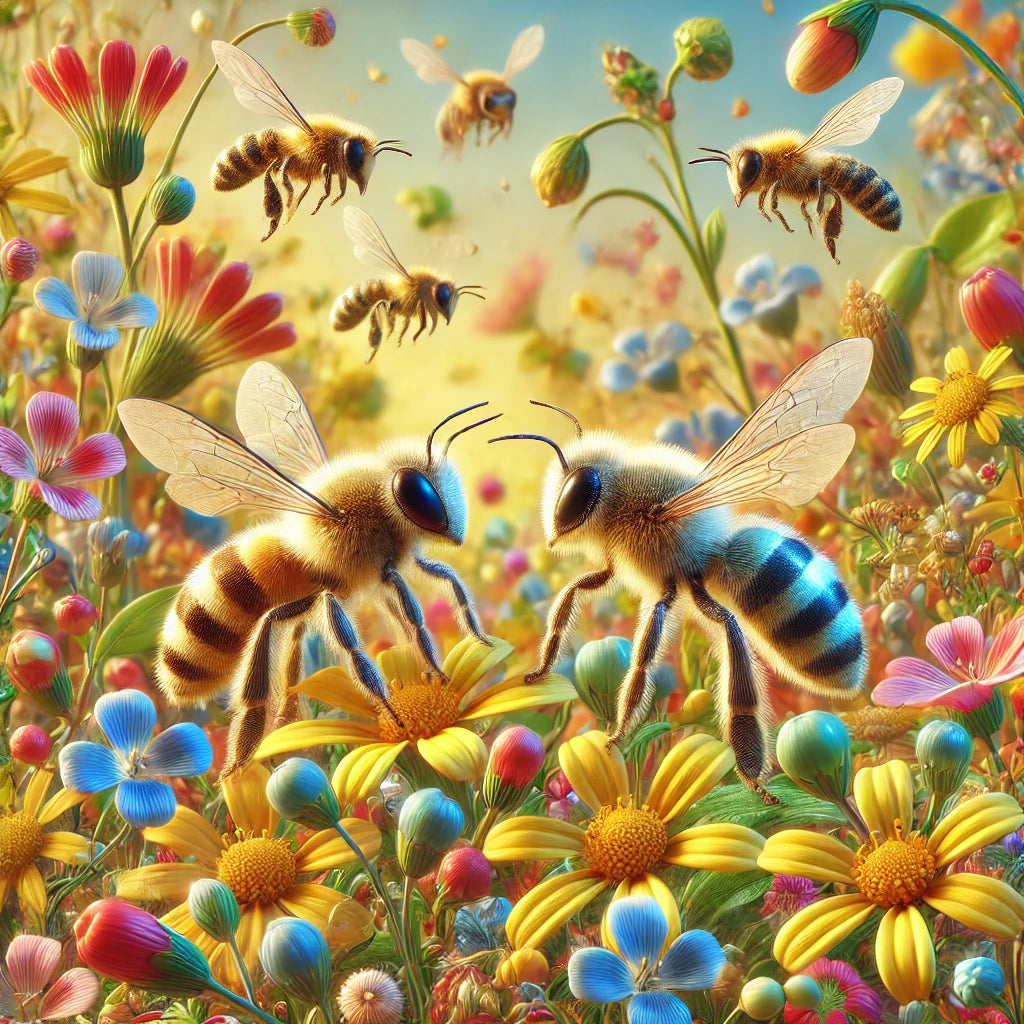Seeing tiny bee-like insects buzzing around might leave you wondering if they’re truly bees or simply look-alikes. Little bees and bee-like insects are essential for pollination, and understanding their differences can help you appreciate their unique roles.
From native bees to wasp species that mimic bees, this guide helps you identify these small creatures and explores their significance in nature. Plus, we’ll touch on how bees contribute to agriculture and the tools available for bee management.
Types of Little Bee-Like Insects
Several insects resemble bees but belong to different species. Here are some common tiny bee-like insects and how to distinguish them from actual bees:
- Sweat Bees: Sweat bees are small, often metallic-colored bees attracted to human sweat for its salt content. These little bees play a crucial role in pollination, and despite their size, they’re valuable to ecosystems. Learn more about the life cycle of bees to understand their important roles.
- Hoverflies: Known for their bee-like coloring, hoverflies are often mistaken for small bees. They mimic bees to avoid predators, but they are harmless to humans and do not sting. Hoverflies are valuable pollinators, contributing to gardens and natural habitats.
- Miniature Wasps: Some wasp species, such as the pollen wasp, have a bee-like appearance and feed on nectar and pollen. Unlike bees, they do not have fuzzy bodies and tend to have a more slender shape. Wasps can also be beneficial by preying on other insects.
Understanding these look-alikes helps you differentiate between actual bees and mimics, adding to your knowledge of insect biodiversity.
The Benefits of Bees: Why Bees Matter
Bees play an irreplaceable role in pollination, which supports agriculture, ecosystems, and biodiversity. From large honeybees to tiny sweat bees, each species contributes to food production and plant life. Here are a few ways in which bees benefit humans:
- Pollination and Agriculture: Bees are critical to crop pollination, helping fertilize plants that produce fruits, vegetables, and nuts. Without bees, crop yields would decline significantly, affecting food supply and biodiversity. Discover more on why honeybees are so vital to agriculture.
- Supporting Ecosystems: Beyond agriculture, bees contribute to natural ecosystems by pollinating wild plants. These plants form the foundation of many food chains, supporting other species and creating a balanced environment.
- Personal and Commercial Use: Bees also produce honey, beeswax, and other byproducts used in cosmetics, food, and medicine. Understanding the benefits of bees highlights their economic importance.
These benefits showcase how integral bees are to both nature and human life, underscoring the need for their protection and conservation.
Managing and Attracting Bees: Tips for a Bee-Friendly Space
If you’re interested in fostering a bee-friendly environment or managing bees around your property, here are some helpful tips:
- Using Bee Trap Attractants: Bee traps can help you control bee populations safely. Bee trap attractants offer an effective way to manage bees without harming them, making it easy to encourage beneficial pollination without overcrowding your space.
- Starting a Bee Farm: Starting a small bee farm is a great way to support local ecosystems and benefit from honey production. With the right resources, you can learn how to start a bee farm and contribute positively to the environment.
- Installing Beetle Traps for Beehives: Beetles can disrupt beehives and threaten bee health. Using beetle traps for beehives is an effective way to protect hives from unwanted pests, helping maintain a healthy bee population.
Creating a bee-friendly space with proper tools and practices helps maintain bee populations while ensuring your garden and crops thrive.
Bee Hive Relocation: Safe Solutions for Bee Management
Occasionally, bees may settle in inconvenient places on your property. Rather than exterminating them, consider bee hive relocation as a humane solution. Professional relocation services safely move bees to a more suitable location, preserving them while maintaining safety.
- Professional Relocation: Professionals have the tools and knowledge to relocate hives without harming bees or risking stings, allowing them to continue contributing to pollination.
- Supporting Bee Populations: Relocating hives supports bee conservation by preserving colonies rather than destroying them. This approach aligns with eco-friendly practices that protect biodiversity.
By choosing hive relocation, you can manage bee populations responsibly while supporting the environment.
Start a Thriving Bee Farm With Swarm Commander
From tiny bees to insects that mimic them, understanding the roles of these creatures in our ecosystem helps foster appreciation and awareness. Whether you’re identifying little bee-like insects or learning how to start a bee-friendly space, each step supports the environment and enhances biodiversity. For resources on bee management and digital solutions, explore Swarm Commander for tools that make managing bees and creating a bee-friendly space easier.
Frequently Asked Questions About Bee-like Insects
Q1. How can I identify little bee-like insects around my garden?
Little bee-like insects include species such as sweat bees, hoverflies, and small wasps. Observing their body shape, color, and behavior can help you distinguish between actual bees and mimics.
Q2. Why are bees so essential to agriculture and ecosystems?
Bees are critical for pollination, which supports crop production and plant life. Their role in pollination benefits food supply, biodiversity, and natural ecosystems. Learn more about why honeybees are so vital to agriculture.
Q3. Can I start a bee farm in my backyard?
Yes, with the right tools and knowledge, you can start a small bee farm to support local ecosystems and produce honey. Check out our guide on how to start a bee farm to get started.
Q4. How do I manage bees safely around my property?
Consider using bee trap attractants or beetle traps to control bee populations and pests. For humane management, look into professional bee hive relocation services.
Q5. What is the best way to protect a beehive from beetles?
Installing beetle traps for beehives helps protect beehives from beetles, ensuring a healthy hive and safeguarding bee health.



